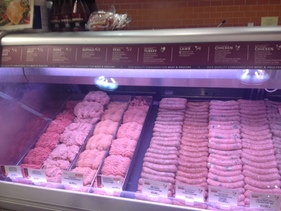This blog was co-wriiten by myself and Danielle McCleery to provide readers with detailed information of our progress on our research of meat labels. Researching and then some…….
Our research project has been coming along quite nicely. On Thursday, April 19th, we took a trip to Whole Foods Market in Marlton, NJ. Neither of us have ever been in a whole foods market and were quite blown away by the displays and variety of foods that they offer. We made our way over to the meat department where we were “WOWED” with quite a display of meat. The meat was not pre-packaged but rather displayed in cases. Costumers made their ways up to the counter and told the butchers what they like. The meat was labeled with individual descriptions and their ratings.
We asked the butcher some questions and he informed us that the stores do not carry a lot of 5 and 5+ rated meats yet. The only 5 and 5+ rated foods they carry right now is for chicken. The butcher explained to us how the closest to #5 rating the better conditions the animal lived in. As we took in everything the butcher told us, our minds were reeling. We were trying to figure out how we were going to proceed with our project. That’s when it hit us! We each decided to buy the best meat available and then go to Shop Rite and buy the best meat they have available. We are going to cook using both meats and ask people to be test takers. We want to test to see if consumers can taste the difference between grass fed beef from Whole foods and average beef from Shop Rite.
We had decided to change our project once again, but this time for the last time! Now we are researching the difference between the meats sold at Whole Foods and the meats sold at Shop Rite. We took separate trips to Shop Rite and bought meat. We both spoke to the butcher’s on our separate visits (at separate stores) but received similar responses when asked where the beef comes from. Danielle’s butcher couldn’t really tell her, he had no idea. Angela’s butcher went on and on to say how Shop Rite makes sure to buy only high quality meat with no pink slime. The problem is, the question wasn’t about pink slime, the question was, “Where does the beef come from?” Angela’s butcher had no concrete answer either.
Since Friday we have both performed individual taste testing on the meat at home. Danielle prepared burgers for her family and Angela prepared meatballs for her family. The results are pretty interesting and we will share our results very soon! We are both very busy composing more research on Shop Rite and Whole Foods as we speak. We are both very excited about our new topic and can’t wait to see where our results lead us.
This blog post is all about collaboration and answers the question: What are the different types of collaboration and what types of collaboration have you done before.
After reading Fontaine and Hunter's article on collaborative writing I've learned that there are two forms of collaboration, dialogue and writing. In the article the authors state that all writing is collaborative to some point. We all get ideas from somewhere. I have used both types of collaboration in my everyday life and in school. I collaborate with my husband on a daily basis about what's best for the kids, or what's for dinner. I collaborate with students in my class during peer reviews, group projects, etc. I am collaborating with two students right now on a lesson plan for our second grade students. Collaboration is necessary and very useful in all aspects of life.
This blog post will answer the question: What is your understanding of being a reflective and reflexive researcher?
In order to understand the difference of a reflective and reflexive researcher we must first understand the difference between reflective and reflexive. Qualley defines Reflexivity as a "response triggered by a dialectical engagement with the other - other idea, theory, person, culture, text, or even another part of ones self or past life." Reflection is different because it originates in the self unlike reflexivity. "When we reflect, we fix our thoughts on a subject." We consider or meditate when we reflect.
A reflective researcher will be more likely to consider all the evidence before coming to a conclusion. They will mediate and consider all aspects of the research. A reflexive researcher will make conslusions based on interactions with other people. They will be more likely to research people, theories, and texts.


 RSS Feed
RSS Feed